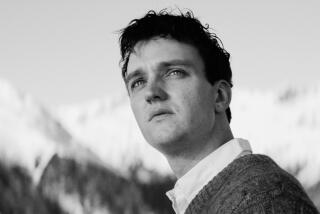‘Arrival’ cinematographer Bradford Young dives deep into the shadows
If you knew what your future was going to be, would it change your behavior? This is just one of the thought-provoking themes in director Denis Villeneuve’s latest film, “Arrival.”
Based on an adaptation of Ted Chiang’s short “Story of Your Life,” the account takes place after a group of mysterious spacecraft land across the globe. Unsure of their intentions, the military bands a team of specialists led by linguistic expert Louise Banks (Amy Adams) and physicist Ian Donnelly (Jeremy Renner), who must determine if they’ve come in peace or are a threat. As Louise deepens her communication and understanding of the creatures’ complex visual language, she begins experiencing lucid memories that become the key to unlocking the reason behind their visit.
The story is not your typical science-fiction apocalyptic trope but instead questions mortality in an internal and psychological way with the fantastical element of an extraterrestrial encounter. Cinematographer Bradford Young says Villeneuve wanted to approach the film as a “boring Tuesday morning then the aliens show up,” adding, “Denis came up with the term of making a ‘dirty sci-fi film’ and not being concerned with straight lines or the perfectly textured alien or the perfectly modeled ship where the aliens have access to the same alloys and physics we have on Earth. He wanted to strip all that away and present these particular levels of humility instead of a visual spectacle.”
The opening sequence shows Louise’s relationship with her daughter, Hannah, which becomes central to understanding who Louise is as well as being a fundamental plot component. To build Louise as a character, Young looked to her as someone he already knows. “We came into the equation thinking she was a friend or next-door neighbor instead of a character we are trying to build. When you treat her like someone you know you don’t have to get into all the meta of the character. It’s already in you. You just sympathize with Louise and design a visual palette that expresses it,” he says.
Young used a mixture of grays, blues, brown and milky blacks to shape the color palette capturing images on the ARRI Alexa with spherical and super-speed lenses. “Shooting digital gave us the opportunity to go darker and deeper into the shadows like never before and we created texture by being disciplined with our lens choice. The way we approached photographing the film was to be very raw yet naturalistic, exploring the darkness as unknown rather than a frightening premise.”
When Louise takes her first journey to enter the ship, which was a fully practical set designed by production designer Patrice Vermette, a shallow depth of field helped to create an irrational fear as she embarks into an unfamiliar world. “That sequence is relentlessly from her perspective,” says Young. “We wanted the audience to walk away with the same amount of questions she had, which were ‘What am I doing here?’ and ‘What is this thing?’”
In the edit, Joe Walker further enhanced the viewpoint shot by Young. “It’s a long build, one where she’s immersed without a night of sleep with a sort of terrifying prospect of this big death granite figure in front of her. They used a focal length where the lens is very much on her shoulders so we carefully managed the claustrophobia as they make all these choices about how to enter the spacecraft,” says Walker.
“Joe had us saying that this film didn’t have to be consistent, it just has to be emotional. He is a surgeon with a big heart and is invested to make sure the images stay delicate and pure,” Young notes. “We had to decolonize our minds in a way that allowed this film to be inconsistent in a perfect way as we didn’t want people to get caught up in the idea that ‘everything is so beautiful’ — that would be wrong for this film.”
Walker adds, “When you have a twist, we wanted to be generous with our storytelling and land on the philosophical points we were trying to make. I often think of how you feel about a film while approaching your car. Are you thinking about your day or is the film still resonating and asking you a question?”
See the most read stories this hour »
More to Read
From the Oscars to the Emmys.
Get the Envelope newsletter for exclusive awards season coverage, behind-the-scenes stories from the Envelope podcast and columnist Glenn Whipp’s must-read analysis.
You may occasionally receive promotional content from the Los Angeles Times.







